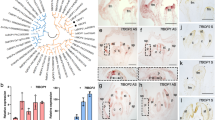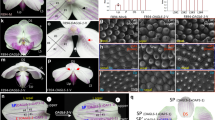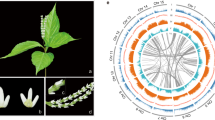Abstract
Molecular genetic studies in Arabidopsis thaliana and other higher-eudicot flowering plants have led to the development of the ‘ABC’ model of the determination of organ identity in flowers, in which three classes of gene, A, B and C, are thought to work together to determine organ identity1,2. According to this model, the B -class genes APETALA3 (AP3) and PISTILLATA (PI) act to specify petal and stamen identity. Here we test whether the roles of these genes are conserved throughout the angiosperms by analysing the expression of AP3 and PI orthologues in the lower eudicot subclass Ranunculidae. We show that, although expression of these orthologues in the stamens is conserved, the expression patterns in the petals differ from those found in the higher eudicots. The differences between these expression patterns suggest that the function of AP3 and PI homologues as B -class organ-identity genes is not rigidly conserved among all angiosperms. These observations have important implications for understanding the evolution of both angiosperm petals and the genetic mechanisms that control the identities of floral organs.
This is a preview of subscription content, access via your institution
Access options
Subscribe to this journal
Receive 51 print issues and online access
$199.00 per year
only $3.90 per issue
Buy this article
- Purchase on Springer Link
- Instant access to full article PDF
Prices may be subject to local taxes which are calculated during checkout




Similar content being viewed by others
References
Coen, E. S. & Meyerowitz, E. M. The war of the whorls: genetic interactions controlling flower development. Nature 353, 31–37 (1991).
Meyerowitz, E. M. et al. Agenetic and molecular model for floral development in Arabidopsis thaliana. Development 1, 157–167 (1991).
Irish, V. F. & Kramer, E. M. in Advances in Botanical Research 197–230 (Academic, San Diego, (1998).
Theissen, G. & Saedler, H. MADS-box genes in plant ontogeny and phylogeny Haeckel's ‘biogenetic law’ revisited. Curr. Opin. Gen. Dev. 5, 628–639 (1995).
Bowman, J. L. Evolutionary conservation of angiosperm flower development at the molecular and genetic levels. J. Biosci. 22, 515–527 (1997).
Kramer, E. M., Dorit, R. L. & Irish, V. F. Molecular evolution of genes controlling petal and stamen development: Duplication and divergence within the APETALA3 and PISTILLATA MADS-box gene lineages. Genetics 149, 765–783 (1998).
Jack, T., Brockman, L. L. & Meyerowitz, E. M. The homeotic gene APETALA3 of Arabidopsis thaliana encodes a MADS box and is expressed in petals and stamens. Cell 68, 683–697 (1992).
Goto, K. & Meyerowitz, E. M. Function and regulation of the Arabidopsis floral homeotic gene PISTILLATA. Genes Dev. 8, 1548–1560 (1994).
Purugganan, M. D., Rounsley, S. D., Schmidt, R. J. & Yanofsky, M. F. Molecular evolution of flower development: Diversification of the plant MADS-box regulatory gene family. Genetics 140, 345–356 (1995).
Bowman, J. L., Smyth, D. R. & Meyerowitz, E. M. Genes directing flower development in Arabidopsis. Plant Cell 1, 37–52 (1989).
Zachgo, S. et al. Functional analysis of the Antirrhinum floral homeotic Deficiens gene in vivo and in vitro by using a temperature-sensitive mutant. Development 121, 2861–2875 (1995).
Sommer, H. et al. Properties of deficiens, a homeotic gene involved in the control of flower morphogenesis in Antirrhinum majus. Development 1 (suppl.), 169–175 (1991).
Ronse Decraene, L. P. & Smets, E. F. An updated interpretation of the androecium of the Fumariaceae. Can. J. Bot. 70, 1765–1776 (1992).
Kelly, A. J., Bonnlander, M. B. & Meeks-Wagner, D. R. NFL, the tobacco homolog of floricaula and leafy, is transcriptionally expressed in both vegetative and floral meristems. Plant Cell 7, 225–234 (1995).
Hardenack, S., Ye, D., Saedler, H. & Grant, S. Comparison of MADS box gene expression in developing male and female flowers of the dioecious plant white campion. Plant Cell 6, 1775–1787 (1994).
Takhtajan, A. Evolutionary Trends in Flowering Plants (Columbia Univ. Press, New York, (1991).
Drinnan, A. N., Crane, P. R. & Hoot, S. B. in Early Evolution of Flowers (eds Endress, P. K. & Friis, E. M.) 93–122 (Springer, New York, (1994).
Kosuge, K. Petal evolution in Ranunculaceae. Plant Syst. Evol. 8 (suppl.), 185–191 (1994).
Carr, S. & Irish, V. Floral homeotic gene expression defines developmental arrest stages in Brassica oleracea L. vars. botrytis and italica. Planta 201, 179–188 (1997).
Lincoln, C., Long, J., Yamaguchi, J., Serikawa, K. & Hake, S. Aknotted1-like homeobox gene in Arabidopsis is expressed in the vegetative meristem and dramatically alters leaf morphology when overexpressed in transgenic plants. Plant Cell 6, 1859–1876 (1994).
Smith, L., Greene, B., Veit, B. & Hake, S. Adominant mutation in the maize homeobox gene, Knotted-1, causes its ectopic expression in leaf cells with altered fates. Development 116, 21–30 (1992).
Chase, M. W. et al. Phylogenetics of seed plants: an analysis of nucleotide sequences from the plastid gene rbcL. Ann. Missouri Bot. Gard. 80, 528–580 (1993).
Acknowledgements
We thank P. Jenik for antibody preparation, and I. Dawson, P. Jenik, T. Hill, C.Juarez, R. Lamb and Q. Tan for comments on the manuscript. This work was supported by grants from the NSF and USDA to V.F.I.
Author information
Authors and Affiliations
Corresponding author
Rights and permissions
About this article
Cite this article
Kramer, E., Irish, V. Evolution of genetic mechanisms controlling petal development. Nature 399, 144–148 (1999). https://doi.org/10.1038/20172
Received:
Accepted:
Issue Date:
DOI: https://doi.org/10.1038/20172
This article is cited by
-
The genetic architecture of floral traits in the woody plant Prunus mume
Nature Communications (2018)
-
Identification and expression analysis of seven MADS-box genes from Annona squamosa
Biologia plantarum (2017)
-
Functional analysis of the promoters of B-class MADS-box genes in London plane tree and their application in genetic engineering of sterility
Plant Cell, Tissue and Organ Culture (PCTOC) (2017)
-
Phenotypic, genetic and molecular characterization of 7B-1, a conditional male-sterile mutant in tomato
Theoretical and Applied Genetics (2017)
-
The developmental and genetic bases of apetaly in Bocconia frutescens (Chelidonieae: Papaveraceae)
EvoDevo (2016)
Comments
By submitting a comment you agree to abide by our Terms and Community Guidelines. If you find something abusive or that does not comply with our terms or guidelines please flag it as inappropriate.



